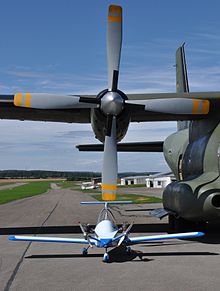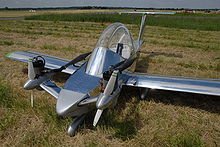CriCri
| CriCri | |
|---|---|

|
|
| Type: | Microplane |
| Design country: | |
| Manufacturer: |
Michel Colomban |
| First flight: |
19th July 1973 |
| Number of pieces: |
approx. 200 |

The CriCri ( French Grille ) is the smallest and cheapest twin-engine airplane in the world. Despite the low maximum take-off weight of less than 200 kg, the single-seat CriCri is not an ultralight aircraft . Since it is man-carrying, it is not a large model airplane . The construction was based on the approval regulation FAR Part 23 (today EASA - CS-23 ) and is approved in Germany as a twin-engine machine with less than 2000 kg take-off weight (D-GXXX) as a single piece in the restricted special class.
development
In the 1960s who started aerodynamics - engineer Michel Colomban a research project. He wanted to build a small and economical airplane. After a series of calculations, Michel came to the conclusion in 1957 that the aircraft would get by with a maximum take-off weight of 180 kg with a load-bearing surface of 4 m². The minimal construction should have a 15 kW motor as drive . However, construction could not start at this time. It was not until twelve years later that the conditions for the start of construction were favorable. In the meantime, some changes have been made to the original project:
- Metal should be used instead of wood.
- The load-bearing area was reduced to 3.1 square meters .
- Two 7 kW chainsaw motors from the French manufacturer JPX replaced the not yet existing 15 kW machine. The shared power had a positive effect on propeller efficiency in fast flight.
- Instead of the cross tail, a T-tail should be attached to protect against obstacles on the ground and to improve aerodynamics .
The result was the MC-10 . Lengthy tests were carried out due to the many design innovations.
First flight
On June 23, 1973 had a prototype its roll-out in Guyancourt . It had an empty weight of only 63 kg and was therefore lighter than its builder. The maiden flight took place on July 19, 1973 - also in Guyancourt. The test pilot was Robert Buisson , a former fighter pilot with a lot of flying experience. In the same year the MC-10 was presented to the public at the National Amateur Constructors Meeting in Montargis . Further appearances followed in 1974 and 1975.
Versions
Internal combustion engine
Countless test flights were made with the MC-10, the findings of which were used to build a safer and more reliable version. However, it took almost ten years until the successor version MC-15 was ready.
Electric drive
On September 2, 2010, a very quiet electric version of the CriCri with the registration number "F-PRCQ" took off from Le Bourget on its maiden flight. In two gondolas mounted on both sides near the tip of the fuselage, a total of four brushless electric motors drive four three-blade propellers (counter-rotating, two pull and two push propellers). The construction of lighter carbon fiber reinforced plastic compensates for the higher weight of the electric drive at 175 kg take-off weight. Powered by lithium polymer batteries (100 V, 5 Ah) weighing 26.8 kg, the aircraft achieves a rate of climb of 5.3 m / s or a top speed of 250 km / h and a cruising speed of 110 km / h for 30 minutes . It allows 15 minutes of aerobatics. Developed in cooperation with Aero Composites Saintonge and the Green Cri-Cri Association, the EADS (Innovation Works) model is used to research the integration of electric drives in aircraft at low cost and to promote a helicopter hybrid drive concept.
On July 9, 2015, the French pilot Hugues Duval flew in an electric CriCri from Calais to England and back again. It was the first flight of a battery-powered electric aircraft on this historic route . He thus preceded one of Airbus' E-Fan crossing of the English Channel in an electric aircraft planned for July 10, 2015.
Technical specifications
| Parameter | MC-10 | MC-12 cricket | MC-15 |
|---|---|---|---|
| crew | 1 | ||
| span | 5.00 m | 4.90 m | |
| length | 3.90 m | ||
| height | 1.50 m | ? m | 1.20 m |
| Wing area | 3.1 m² | ||
| Empty mass | 63 kg | 75 kg | 78 kg |
| Max. Takeoff mass | 170 kg | ||
| Cruising speed | 170 km / h | 185 km / h | |
| Top speed | 200 km / h | 210 km / h | |
| Max. Load factor | +9 g , −4.5 g | +4.5 g , −2.5 g | |
| Takeoff route | 150 m | 120 m | |
| Climb performance | 3 m / s | 6 m / s | |
| Service ceiling | ? m | ? m | 4500 m |
| Range | 750 km | 500 km | 300 km |
| Engines | 2 × 7 kW | 2 × 11 kW | |
| propeller | 2 × 2-blade propellers | ||
A CriCri is exhibited in the Deutsches Museum in Munich .
See also
- Bede BD-5 , a similarly compact, but single-engine kit plane (kit plane)
- Leza-Lockwood Aircam , a two-seat twin-engine and inexpensive kit airplane
Web links
Individual evidence
- ↑ FliegerRevue October 2010, p. 7, Cri-Cri with electric drive
- ↑ http://www.aerokurier.de/de/aviation/flugzeuge/eads-fliegt-viermotorige-cri-cri-mit-elektroantrieb.28591.htm ( page no longer available , search in web archives ) Info: The link was created automatically marked as defective. Please check the link according to the instructions and then remove this notice. EADS flies four-engine Cri Cri with electric drive, aerokurier.de, VKT, July 22, 2010, accessed May 2, 2013
- ↑ http://www.fliegermagazin.de/news/detail.php?class=6&objectID=4212 fliegermagazin.de, July 16, 2010, accessed May 2, 2013
- ↑ http://www.flugrevue.de/de/technik/technik/eads-erstflug-des-ersten-kunstflugzeugs-mit-elektroantrieb.32172.htm EADS: First flight of the first electric aerobatic aircraft, Flugrevue.de, SST, 2 September 2010, accessed May 2, 2013
- ↑ http://www.innovations-report.de/html/berichte/verkehr_logistik/cri_cri_flugzeug_vollelektischem_antrieb_haben_ab_160914.html The Cri-Cri - an aircraft with a fully electric drive takes off, innovations-report.de, Gregor v. Kursell, September 2, 2010, accessed May 2, 2013
- ↑ Crossing the English Channel in an electric plane

